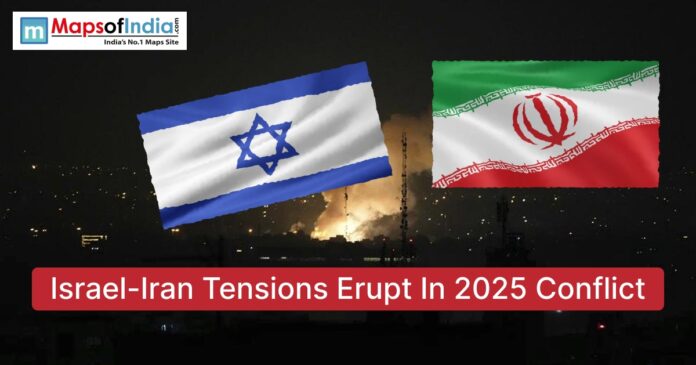The Middle East has once again become the center of international concern as tensions between Israel and Iran have erupted into open warfare. After decades of proxy battles, cyberattacks, and diplomatic threats, June 2025 has marked a decisive turning point—transforming what was once a cold conflict into a full-fledged war between two of the region’s most influential powers.
This unfolding situation not only endangers regional stability but also threatens global peace, energy supplies, and the fragile diplomatic balances that have been painstakingly built over the years.
Decades of Cold Conflict Boil Over
Over the past four decades, a frosty relationship between Israel and Iran has been characterized by ideological differences, strategic competitions and politics of hatred. Israel has always claimed that Iran has been funding terrorist groups such as Hezbollah and Hamas among others, and Iran on the other hand has never ceased to demand the eradication of the Israeli nation and has always treated the Jewish nation as a proxy of the western imperialists in their possession.
There were certain hostilities in previous years which were carried out predominantly on the level of secret activities: selective killings of nuclear scientists, cyberattacks (including the so-called Stuxnet virus), and airstrikes against the Iranian military bases in Syria and Iraq. However, such indirect modes of warfare were no longer able to hold the pressure.
The Spark: Operation Rising Lion
On June 13, 2025, Israel conducted a military campaign unheard of, which was code-named Operation Rising Lion, to target the main military and nuclear infrastructure of Iran. The attacks were profound, tactical and devastating. There was heavy bombing in key locations in Natanz and Isfahan, possible sites of shooting missiles were hit and the air defense of Iran was rendered ineffective with the help of cyber and drone-based sabotage.
This action was the first occasion when Israel acknowledged direct strikes into Iranian territory on the scale. Israeli sources indicate that the strategy was meant to disable the ніuclear capabilities of Iran, which were on the border of being weaponized.
Iran Strikes Back: A Nation on Fire
At the speed of light, Iran pulled back. In less than 48 hours afterwards, Tehran resorted to Operation True Promise III, a volley of ballistic missiles and drones, which were fired and directed at Israel’s major cities. The attack wrought most of its damage in Tel Aviv, Haifa and surrounding areas. The missiles did not reach their targets, and a majority of them were intercepted by the Iron Dome and associated systems of Israel’s defense, thereby causing injury to civilians and causing severe damage to the infrastructure.
Roads, residential complexes in Israel and public buildings were visibly destroyed. At the same time, in Iran, the Israeli airstrikes had already caused mayhem-mass evacuation of the civilians out of the major cities and general panic as to what could be next.
A Humanitarian Crisis Unfolds
Ordinary people are bearing the biggest price of this war as is the case in any conflict. In Iran, families are leaving their cities by thousands of families seeking safety. The shortages of food, fuel and medical supplies have resulted in panic buying. Access to electricity and the internet is erratic with frequent blackouts and electricity cuts that make it difficult to provide relief.
Israel, also, is suffering the blow of 24/hour sirens, bomb shelters, and unanticipated deaths. Civilian population types such as hospitals and schools have been forced to close or establish their operations in safer areas.
Humanitarian organizations across the globe are raising a red flag and demanding action to be taken to save the lives of non-combatants yet none of the safe corridors have yet opened and there are no ceasefire talks on the horizon.
The United States and the Global Response
Global powers have inevitably been drawn in the war. In the Middle East, the United States, a long-term ally of Israel, has adopted an ambivalent position caressing publicly to give restraint, although secretly, the intensity to assist Israel defend itself by providing intelligence and logistical backing. President Trump is also in such a position: a candidate pledging to dial down American intervention in distant wars now must drift through a diplomatic tightrope.
Russia has also been concerned and volunteered to flex its muscles as a mediator since Russia has a good relationship with Iran and it has some interests in the stability of the Middle East. European countries have convened emergency summits and the United Nations has made formal appeals, asking parties to ceasefire, which has done little on the field.
The Proxy Threat Returns
Although the major warfront involves Israel and Iran, other stakeholders are also fast being dragged into the situation. Hezbollah in Lebanon has been seen as getting ready to enter the game. The Iraq militia groups which are backed by Iran have vowed to attack the interests of the Israel and American states in Iran. Houthi rebels of Yemen have renewed their drone attacks on Israeli targets in another country.
To curb this, Israel has increased its raids on these threats, usually on suspected weapons stockpiles, and training camps in Lebanon, Syria and Yemen. The expansion of the battleground strengthens the possibility of regional spill-over, a situation that would ensure that the war becomes exceedingly hard to manage.
Economic Shockwaves and Oil Market Panic
Not surprisingly major economic consequences are being felt worldwide by the war. Oil prices rocketed above 100 dollars a barrel with the fears that trade routes such as Strait of Hormuz may be closed. Shipping firms have detoured ships to an alternative route to bypass the war zone, and airlines have stepped back on flights to the areas.
Even the already known problem of inflation is likely to skyrocket in the following weeks as the supply chains are disrupted. Asian, European, and American stock markets have been slumping and investors are rushing to transfer assets into safer forms.
Media Warfare and the Battle of Narratives
Running concurrently to the battlefield is the information war being carried on by both sides. Israel has published satellite shots and operational videos to support their preemptive attacks, and Iran has demonstrated that their missile program is stronger and will prevail, and the nation is united. Social media is filled with emotionally motivated material, propaganda, and even sometimes, misinformation.
This contest of stories is vital, particularly because the two countries are trying to drum up international sympathy and keep the people at home strong.
What Happens Next? Possible Scenarios
Currently, there are three major situations that may take place:
1. Prolonged War
In case either of the two countries declines to give in, it is possible to see months, not to say, years of continuous battles, with more and more regional players being involved and an increase in the civilian casualties.
2. Mediated Ceasefire
The region needs a breakthrough either by the U.S., Russia, or coalition in the UN in order to achieve a temporary truce, humanitarian relief, and have peace negotiation. Nevertheless, any long-term solution could be prevented due to deep mistrust.
3. Internal Fallout in Iran
Many fear that the attacks by Israel could topple down the Iranian government. The consequences of this are, be it political reform or further, on authoritarianism, it will highly have implications to the region.
Conclusion: A Crossroads for the Middle East
The 2025 Israel-Iran war is not just a two state conflict; it is a proving ground on the state of international diplomacy, regional stability as well as how the world will fare in general. It can deconstruct borders, remake alliances and change the future of one of the world’s most volcanic regions.
This point of uncertainty also needs the world to unite not only to stop the missiles and airstrikes but also to work on the underlying problems that have occasioned this confrontation. Not only is it a question of the choices of leaders in Jerusalem and Tehran, but also in the determination of the international community to be prepared to work and move quickly as well as wisely before the road ahead leads to destruction or to peace.




